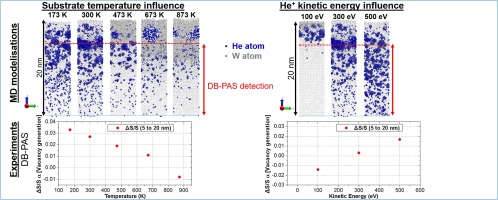当前位置:
X-MOL 学术
›
Acta Mater.
›
论文详情
Our official English website, www.x-mol.net, welcomes your feedback! (Note: you will need to create a separate account there.)
Substrate temperature and ion kinetic energy effects on first steps of He + implantation in tungsten: experiments and simulations
Acta Materialia ( IF 9.4 ) Pub Date : 2017-12-01 , DOI: 10.1016/j.actamat.2017.08.065 Lucile Pentecoste , Anne-Lise Thomann , Pascal Brault , Thomas Lecas , Pierre Desgardin , Thierry Sauvage , Marie-France Barthe
Acta Materialia ( IF 9.4 ) Pub Date : 2017-12-01 , DOI: 10.1016/j.actamat.2017.08.065 Lucile Pentecoste , Anne-Lise Thomann , Pascal Brault , Thomas Lecas , Pierre Desgardin , Thierry Sauvage , Marie-France Barthe

|
Abstract Helium implantations are experimentally performed in order to observe the formation of vacancy defects in tungsten crystals. Characterizations with nuclear reaction analysis (NRA) and positron annihilation spectroscopy (DB-PAS) allow respectively to quantify the 3 He retention and to determine the nature of the vacancy defects formed during the process. Two types of defects are observed as a function of the impinging fluence: vacancies filled with He (He n V and He n V m>1 ) below 2.5 × 10 20 He.m −2 and small voids above. The influence of kinetic energy of the impinging He atoms and of the substrate temperature during the implantation is studied. Molecular dynamic simulations of the implantations are performed to further understand the formation mechanisms of the initial He n V defects. A good agreement is found between results obtained by simulation and experimentally. The implantation depth of the He atoms and the mobilities of He and W are identified as the main features governing the vacancy formation.
中文翻译:

衬底温度和离子动能对钨中 He + 注入第一步的影响:实验和模拟
摘要 为了观察钨晶体中空位缺陷的形成,实验进行了氦注入。核反应分析 (NRA) 和正电子湮没光谱 (DB-PAS) 的表征分别允许量化 3 He 保留并确定在该过程中形成的空位缺陷的性质。观察到两种类型的缺陷作为撞击注量的函数:低于 2.5 × 10 20 He.m -2 的填充有 He(He n V 和 He n V m>1 )的空位和上方的小空隙。研究了注入过程中撞击 He 原子的动能和衬底温度的影响。进行注入的分子动力学模拟以进一步了解初始 He n V 缺陷的形成机制。通过模拟和实验获得的结果之间发现了良好的一致性。He 原子的注入深度以及 He 和 W 的迁移率被认为是控制空位形成的主要特征。
更新日期:2017-12-01
中文翻译:

衬底温度和离子动能对钨中 He + 注入第一步的影响:实验和模拟
摘要 为了观察钨晶体中空位缺陷的形成,实验进行了氦注入。核反应分析 (NRA) 和正电子湮没光谱 (DB-PAS) 的表征分别允许量化 3 He 保留并确定在该过程中形成的空位缺陷的性质。观察到两种类型的缺陷作为撞击注量的函数:低于 2.5 × 10 20 He.m -2 的填充有 He(He n V 和 He n V m>1 )的空位和上方的小空隙。研究了注入过程中撞击 He 原子的动能和衬底温度的影响。进行注入的分子动力学模拟以进一步了解初始 He n V 缺陷的形成机制。通过模拟和实验获得的结果之间发现了良好的一致性。He 原子的注入深度以及 He 和 W 的迁移率被认为是控制空位形成的主要特征。



























 京公网安备 11010802027423号
京公网安备 11010802027423号